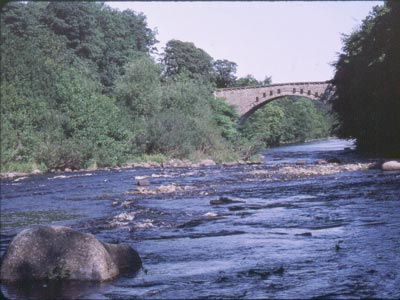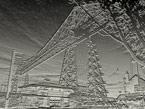
WINSTON BRIDGE

"The blacksmith's shop on the green is surrounded by a litter of rusty farming implements awaiting repairs, and it faces the "Inn of the Four Alls" on the other side of the street. The inn signboard is a curious work of art which must have been designed by a local farmer in a cynical mood. Figures representing the four callings are followed by the appropriate legends.
The Queen; "I govern all."
A soldier; "I fight for all."
A Parson; "I pray for all."
A Farmer; "I pay for all."
(Ovington village.)"
Teesdale. Douglas M Ramsden. 1947
The bridge at Winston is noteworthy as a survivor of the great flood of 1771. It was built as a link in the road system carrying coal from South Durham pits to North Yorkshire, but lost its importance with the coming of the railway. It is a stone bridge soaring high over the Tees. Designed by Sir Thomas Robinson of nearby Rokeby, and erected in 1762-3, it has one arch of 111 ft (34 metres) span, once the longest single span in England. It has recently been strengthened with bolts to retain the spandrel walls.
Winston village is noteworthy for the church of St Andrew's standing above the Tees. Parts of it are 13th century, but the exterior was much restored in Victorian times. The steep river banks are lined by trees and the scenery is very grand, and the river quite wide hereabouts. Ovington is another pleasant village, situated on the south side of the Tees and to the west.
- Constructed - 1762-63
- Type - arch, stone, single span.
- Position: Winston, County Durham.
- Grid Ref: NZ 142 163

